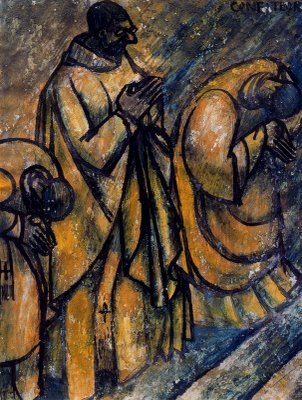634-709AD
Feast: October 12th.
Born to a wealthy family in Northumberland, Wilfred (also spelled Wilfrid) was a second generation Christian.
Although the native Britons were mainly Christians when Roman influence waned in the 5th Century, waves of Anglo-Saxons had invaded and brought their Pagan gods. This was also a time of struggle for dominance within the Church between the Irish/Scottish Celtic Christianity and the Roman tradition.
Wilfred had an interest in the things of God from a young age and went to study in Lindisfarne, a centre of Celtic Christianity, under St Aidan.
To continue his education Wilfred set out to travel to Rome, but stayed for quite a while in Lyon living the high-life. Eventually he arrived in Rome about 654, when he was about 20. He stayed for a short while, but returned to Lyon where he continued his education under the patronage of the Archbishop. However, the Archbishop's wealth and ways caused jealousy among the secular powers and he was put to death along with many of his entourage. Wilfred’s status as a foreign nobleman saved him from an early death.
At the age of about 27 Wilfred set up a magnificent new abbey at Ripon in Yorkshire with fine stonework using skilled men he had brought from France. St Cuthbert and his followers returned to Lindisfarne with their Celtic traditions.
The division between the Celtic and the Roman Church threatened to break into violence so in 664 the newly ordained Wilfred took his seat as an 'expert' at the Council of Whitby and championed the cause of Rome. Rome won.
A year later, Wilfred was appointed Bishop of York by the Pope and he went to France for his ordination. However, he stayed so long in France that Saint Chad was put in as bishop of York. Wilfred returned to his abbey in Ripon fuming.
Theodore, Archbishop of Canterbury, came to Wilfred’s aid three years later. He said that Chad had been irregularly ordained. Chad went away meekly to be an abbot and Wilfred took up York.
Immediately he set about restoring the Cathedral and other churches in the diocese. He provide funds for their upkeep and soon had amassed a great fortune for the Church . His fortune and growing power earned the jealously and fear of the secular powers.
Egfrid, the King of Northumberland, had taken a dislike to Wilfred and his chance for revenge came in 678, Egfrid called up the Archbishop of Canterbury when Wilfred was away doing a spot of missionary work. The King suggested that York was too large a diocese and should be split up. The Archbishop agreed as the proposal had much to commend it pastorally. But upon his return Wilfred, finding his diocese now shrunk was livid and went off to Rome to complain.
It was two years before Wilfred was back in England, vindicated by Rome. He was accepted back into his somewhat smaller diocese, but only for a while. Egfrid soon banished him, so Wilfred went off to do missionary work with the Saxons in Sussex and the Isle of Wight.
A year after the death of Egfrid in 685, Wilfred returned to take up York. He remained in power for five years, after which he was banished by the new king who felt Wilfred was getting to uppity.
In 703 Wilfred, now aged 69, returned to Rome to complain. Again he was vindicated and three years later took up the Archbishopric of York for the last three years of his life.
In 706 he died in Oundle and was buried in the church of St.Peter at Rippon. That monastery having been destroyed by the wars, the greatest part of his remains was translated to Canterbury in the time of St. Odo, and deposited under the high altar, in 959. They were enshrined by Lanfranc, and deposited on the north side of the altar by St. Anselm, on the 12th of October: the day of which translation became his principal festival. These relics are said now to repose near the monument of that truly great man, Cardinal Pole.

